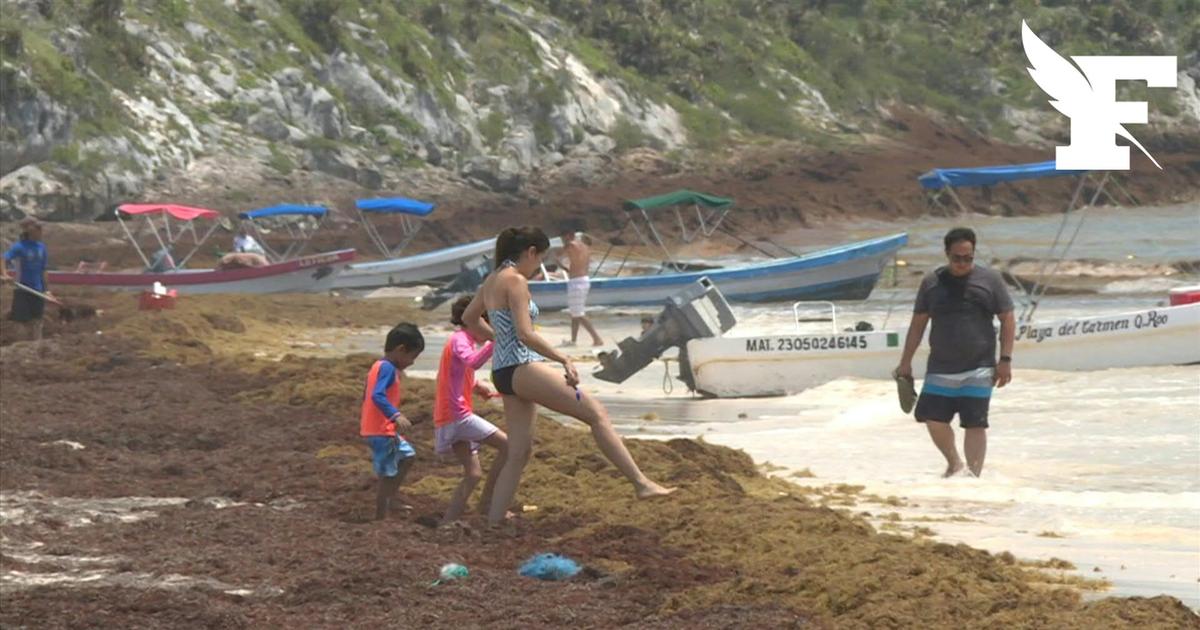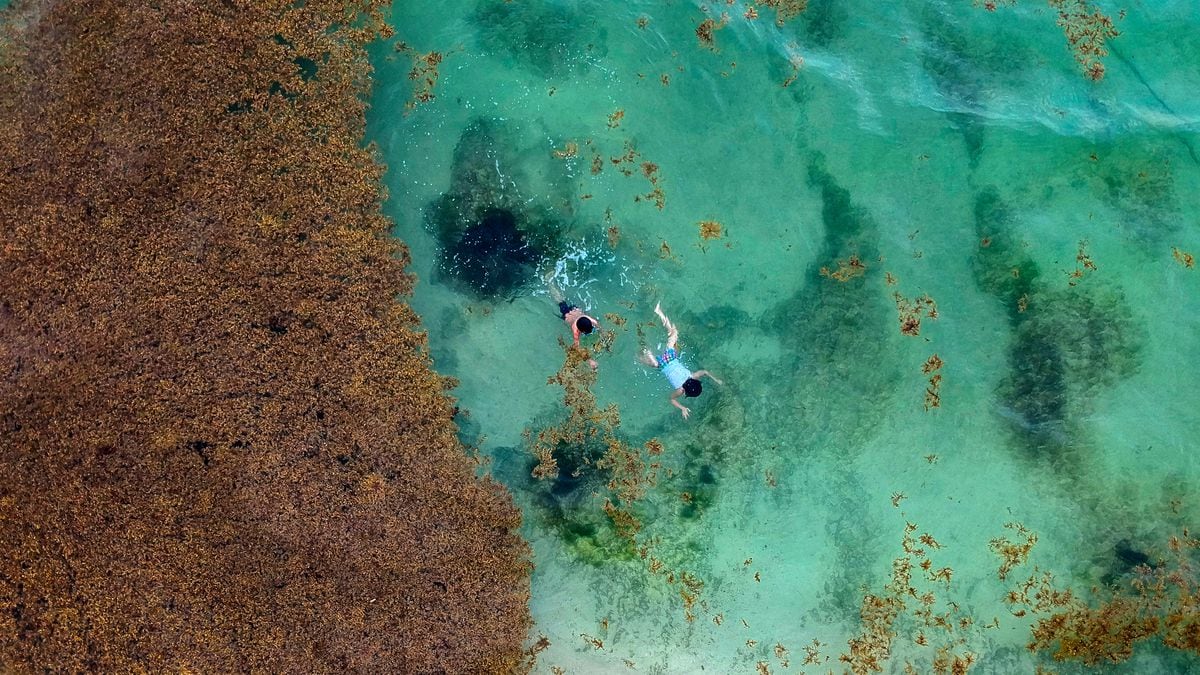They regularly make the headlines.
With their chestnut color and their nauseating odor at the time of decomposition, sargassum tenses as much as it disturbs.
Because these brown algae, which live on the surface of the water and settle on the beach by the hundreds of thousands, constitute a real scourge for the Caribbean and African coasts.
And they should continue to wreak havoc: the coasts of Florida, in the United States, are preparing for a massive arrival of sargassum.
According to the University of South Florida (University of South Florida), this could be the largest shoal ever observed so far.
This should reach its peak between June and July.
A critical situation that Sylvie Gustave Dit Duflo, vice-president of the Guadeloupe region in charge of environmental issues, reported in February.
"
We are expecting a dark year
," she anticipated.
The amount of algae observed in the Atlantic Ocean
"doubled from December to January"
, reaching the sad record of 8.7 million tonnes and beating that of 2018 (6.5 million).
In March, mountains of brown algae massively invaded Guadeloupe and Martinique.
With visible consequences at all levels: environmental, health and economic.
Decryption.
Read alsoSargassum: a “dark year” in perspective for the West Indies
What is sargassum?
Sargassum is a type of brown seaweed.
There are 351 species in the world.
If some of them settle at the bottom of shallow waters, those that invade the Caribbean evolve differently.
Responding to the sweet name of pelagic sargassum,
"they look like small trees, with leaves and floats, which allow them to be on the surface of the water"
, explains Thierry Thibaut, professor of marine ecology at Aix-Marseille University - MIO (Mediterranean Institute of Oceanology).
They develop in the form of "rafts" on the surface of the oceans.
If their presence is nothing new (Christopher Columbus had already been able to observe these brown masses in the 15th century), it is their massive strandings that are worrying.
Because they have visible consequences for the inhabitants and visitors of the coasts.
In the West Indies, three morphotypes have been identified: Sargassum natans I and VIII and Sargassum fluitans III.
Why are the Caribbean and Africa regularly invaded by Sargassum?
As the Ministry of Ecological Transition reminds us,
“Sargassum banks at sea have a very important ecological role”.
Normally, they create a real ecosystem, where hundreds of marine species develop, such as fish or sea turtles.
Problem, at the turn of the 2010s, the first massive strandings of Sargassum were observed in the West Indies, with serious consequences on the victim coasts.
Their origin?
“At the time, there was a huge wind anomaly in the Atlantic Ocean, where westerly winds were dominant.
This pushed what was floating, that is, the historic Sargasso Sea, which was in the northern Atlantic, towards the shores of Europe and Africa.
At that time, whatever was floating encountered the Canary Current, which descends along Africa.
Then it joined the equatorial currents.
Since then, things have been going around in circles between Africa and America
,” explains Thierry Thibaut.
This accumulation zone, between the two continents, has become a privileged ground for Sargassum, pampered by abundant light and warmer water.
In addition, brown algae feed in certain areas of deep water upwelling, loaded with nutrients.
“But what makes them proliferate are their biological mechanisms.
They have adapted well to this part of the ocean”
, continues Thierry Thibaut.
Many unknowns remain, namely the exact origin of the phenomenon, but also the reason why some years the Caribbean coasts are more impacted than others.
However, some leads have been advanced.
As the Ministry of Ecological Transition notes,
"responsibility for human action is very likely"
and global warming could strongly contribute to the phenomenon.
Which areas are most affected?
No territory in the Caribbean seems to escape the invasion of Sargassum.
“The islands of the Antilles serve as a sieve.
The sargassum will enter via the Caribbean Sea, then enter the Gulf of Mexico”
, explains Thierry Thibaut.
"Islands will retain some of what floats."
Barbados, Martinique, Guadeloupe, Cuba, Mexico, Venezuela... the proliferation is such that it is visible from space.
Not to mention Africa, where Côte d'Ivoire, Benin and Togo are also suffering the ravages of brown algae.
If they are in many respects mysterious, the sargassum still follow a more or less precise calendar.
"In winter, they are generally on the side of Africa, then in spring they move towards the Caribbean, before invading the beaches in summer"
, details Thierry Thibaut.
Depending on the year, their quantity is variable.
In 2016, strandings were rather low, unlike 2018, seen as a dark year.
What about the future?
“It is difficult to predict.
Maybe it will stop overnight, maybe the phenomenon will still evolve.
We don't know yet
,” continues Thierry Thibaut.
What are the consequences for the affected countries?
The impact of the proliferation of Sargassum is at all levels.
It is first of all environmental: these algae are a real nightmare for the fauna and flora, which find themselves asphyxiated.
“Thousands of tons sometimes wash up overnight: the seagrass beds suffer.
Because we must not forget that Sargassum sometimes extends over a meter in height.
What is below is smothered”
, continues Thierry Thibaut.
Almost harmless in water, brown seaweed becomes toxic when washed up on shore.
When they putrefy en masse in the sun, they produce toxic gases, such as hydrogen sulphide or ammonia (with a smell of rotten eggs), which represent a real health hazard for residents and visitors. coastlines.
And this, especially since sargassum sometimes has high concentrations of chlordecone, a pesticide harmful to health, used en masse in the French West Indies until 1993 and which still pollutes the soil.
Result: the beaches are forbidden to access, with impacted tourism.
But not only.
Fishermen can no longer navigate properly, and therefore work.
Not to mention the backlash for real estate, buildings located along the coast being victims of corrosion and malfunction of electronic equipment.
So many elements that weigh heavily on local economies.
Faced with this threat, each territory tries to fight with different weapons.
In 2022, France adopted the four-year Sargassum Plan II.
The goal?
Develop research around these brown algae, but also help the local authorities concerned to collect them, at sea and on land, to ensure their transport and storage.
A major challenge, whereas in Guadeloupe for example,
half of the storage sites are already saturated.
In Martinique, citizens have deployed anti-Sargassum nets to prevent them from invading the coast.
What if sargassum were useful?
Often considered as pests, sargassum can nevertheless reveal unsuspected resources.
Fertilizers, biogas, cosmetics... We try to recycle them by all means.
In the French West Indies, several avenues are being studied, including that of the production of insulating blocks, resulting from sargassum and raw earth.
In Saint-Barthélemy, Pierre-Antoine Guibout, a lawyer launched the Sargasse Project at the end of 2018.
His ambition?
Develop a process for transforming brown algae into cardboard pulp.
In Mexico, an entrepreneur reuses them to make... shoe soles.
Another way to enhance this natural resource that has become almost inexhaustible.














